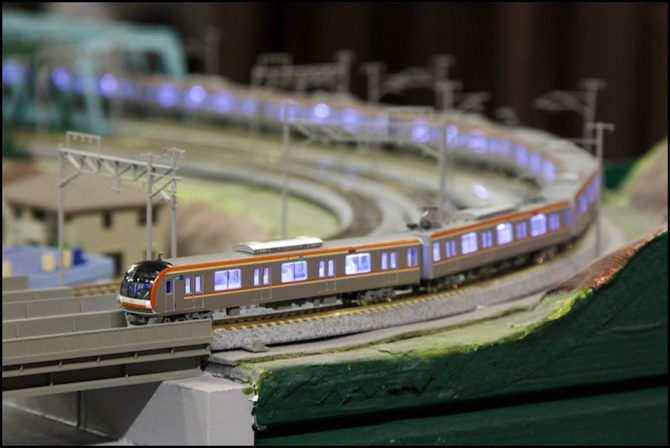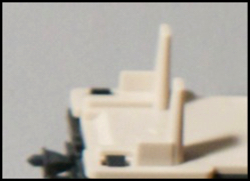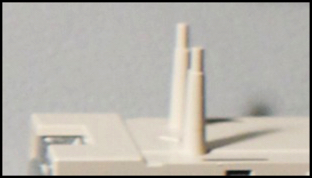Kato Subway Train and December 2011 Monthly Status

My latest Kato model is another subway train, the Tōkyō Metro 10000. I already have a model of this train made by Greenmax, which I have mentioned briefly a few times (it featured in the “first run” video of the subway, see my Subway First Run musing for more on that). It’s not a bad model, but it lacks an interior and requires wire-in decoders for conversion to DCC. And while I’ll eventually get around to that, it’s not high on my priority list. So trains that are easier to convert to DCC, and that means Kato, are at the top of my list for actual operations once I finish up installing all the DCC electronics for the Commuter and Subway loops.
For the above-ground Commuter loop, I have lots of Kato’s commuter EMUs, but trains for the underground Subway loop are another matter. As mentioned back in October I’d hoped to have the Kato Ginza Series 01 be one of those, but it ended up not supporting the EM13 motor decoder (probably due to the narrower width of the cars).
The Kato 10000 had been on my must-buy list anyway, but with fingers crossed that this one would be “DCC Friendly”, I eagerly awaited its arrival. Kato hadn’t actually said it would be DCC Friendly (meaning compatible with their Digitrax-made proprietary decoders) although they rarely do, and there was a cryptic reference to some issue with the interior lighting that had me worried it was some kind of one-off design. I’d previously bought several of Kato’s new “version 2” LED light sets (which I describe more on my new Kato Interior Lighting page) planning to install them in the Ginza train, but hadn’t gotten around to that after it turned out not to support the DCC motor decoder. So my plan was to use them, if I could.
Installation of the lights was done first, after breaking the train in by running in loops on DC for about a half hour to make sure it worked well. Once I was sure they were working, I added the DCC decoders (which went amazingly easy; Kato seems to have finally worked out all of the problems they had with reliable electrical contact for these).
Kato’s definitely made some changes with this train to their basic EMU platform. Mostly the construction is similar, with separate undercarriage and interior floor sections, and two brass strips sandwiched between them that run the length of the car. Each truck picks up power and feeds it to the brass strip, which helps eliminate problems when crossing dead spots like switch frogs. Decoders take power from the brass strips, while interior lighting units use addtional L-shaped brass strips to bring the power up to the light board. This all appears unchanged (and still suffers to an extent from the poor electrical contact that all those strips rubbing on each other loosely have always had).
However, what is different is the support structure that’s part of the interior floor molding. This consists of four posts that hold the clear plastic diffuser strip a fixed height above the floor and align it with the LED on the light board. In the older cars, these posts had a flat top, roughly 8 mm above the car floor (I measured that on my 2011 E233-5000 train, Kato model 10-862/10-863). Because the old strips are solid, they would rest atop the posts, putting their top about 2 mm higher than the post.
On the 10000, which has a body similar in shape to the usual EMU, the strip tapers about 10 mm above the floor to a circular pin, which extends a further 2 mm. The new diffusers have slots that fit over the pins, holding them in place with the top flush with the top of the pin. The floor assembly appears lower, but there is zero clearance above the top of the pin when the body is attached (I tried fitting an old-style diffuser into a 10000 car, and the body could not be closed).
On the Ginza cars, which are smaller, the strip tapers about 6 mm above the floor to a circular pin, which extends a further 2 mm, but the net result is the same. Kato’s newer models will work only with the new lighting kits. Because the new diffuser can still rest above the old-style posts (it is the same width and thickness as the old diffuser) it is probably possible to install the new lighting kits in older cars. I’m not sure if the LED would align properly (it seems like it would).
The new interior lightboards are at least as bright as the old ones, and provide more even lighting the length of the car. This also flicker much less than older ones, although I still saw a small amount of flickering while operating the 10000 on DCC power, indicating that there are still some electrical connectivity issues in the new lightboards.


L: old-style supports, R: new style.
The other changes Kato has made may pre-date this model. Older Kato EMUs had their destination signs done as stickers (self-adhesive, not decals) that you needed to apply to clear plastic destination boards (inside the cab or outside along the sides). These were hard to cut out correctly, and very difficult to fit. Kato is now pre-printing the side signs (you can’t change them) and printing the cab end destination signs on a small bit of translucent white plastic you fit into a bracket inside the cab. It comes with one set pre-installed and several additional sets. Both my 10000 series and the E233-5000 Keiyō Line train I received in October use the new signboards (the E233 is not equipped for the new lightboards however).
Both the E233 and the 10000 have a slightly different design to the cab lightboard also, with the LED actually mounted under the floor (which I don’t think had been the case on older models, although I’ll need to go back and check). In the 10000, this significantly reduces flicker in the headlights (it may eliminate it altogether). I haven’t run the E233 enough yet to know if that’s true of it also. As noted the new interior lights don’t flicker very much at all. The end result is a much nicer appearance for a lit train.
The car runs well. On clean, level track, with my DCC throttle set to “1” (on the Digitrax 0-100 scale) the train creeps along at a scale 4.6 mph (7.4 kph), although it has problems with a 2% slope at that speed, and needs to be raised to 6.4 mph (10.3 kph) to climb that without hesitation. Note that on DC, the slowest I could get it to move reliably on level track was a scale 19 kph. Power consumption is 150 mA standing still with ten cars lit, and running at normal speed adds about 50 mA to that on level track, climbing to 60-70 mA on a grade. Thus maximum power draw is around 220 mA at 12V DCC, and 200 mA is typical.
Operation is smooth, and the motor is so quiet it can’t really be heard over the sound the wheels make. The Greenmax train runs well, but not that well and the motor is quite obvious, though still not “loud”.
Comparing the two models, they are very close in detail. Kato has better detail in the rooftop, but this is really only apparent in the one car with two pantographs, as the conduit between them is a separate raised detail part on Kato, and molded into the body on Greenmax. Kato also has better truck detail (just slightly) and small diaphragms between cars, as well as coming with Kato’s standard body-mount Shibata couplers. With Greenmax you get body-mount Rapido’s by default, but can replace these with others.
Given the costs (Kato costs $277.46 for a ten-car train without lighting or DCC, versus $436.99 for Greenmax) the choice is rather obvious. Greenmax is good, if pricy, for those limited-interest models other manufacturers won’t produce. But they really can’t compete with the larger manufacturers on cost. And at least in this instance, they aren’t demonstrating an edge in detail either.
Monthly Status for December 2011
As the end of December wraps up another year, not much progress has been made this month, and sometimes it seems like little has been done all year, although that isn’t the case. I am still, however, working on the slow assembly of DCC electronics (circuit breakers and occupancy detectors as described previously) but didn’t do much this month. In fact, aside from a bit of playing with my new subway train models, the month largely went to work on the website, converting pages from iWeb and re-converting the ones I’d originally done using the problematic Stacks plugin. I also spent a lot of time on the comments system, which isn’t quite ready, but is essentially done (I just need to do some final checks and testing before I’m ready to put it out for use).
And the new expressway deck is still stuck in mid-build, as it has been since August. And I’m still waiting to re-do the backdrop on the Riverside Scene (since the old one made with 8.5x11 sheets fell apart last summer). Hopefully January will see more actual work being performed on the layout itself, with track DCC and the re-done backdrop being at the top of the list, at least this week.



